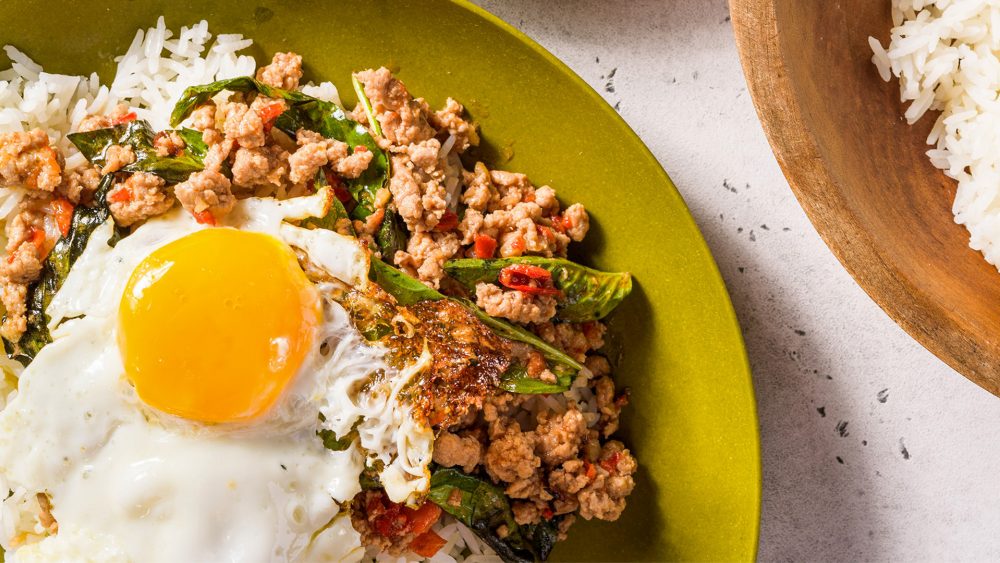It’s one of our favorites from our newest cookbook Milk Street 365: The All-Purpose Cookbook for Every Day of the Year. The dish is short on time but big on flavor, thanks to a combination of high-impact ingredients—homemade garlic-chili paste, a savory-sweet mixture of Asian sauces, and handfuls of fresh basil. It’s finished with a perfectly fried egg with crispy browned edges and a soft, jammy yolk, which acts as a rich sauce to balance the spicy, peppery flavors.
It takes half an hour to prepare from start to finish, including all the chopping and prepping. Once you start cooking, it comes together in a quick 10-15 minutes, so don’t skip the mise en place with this one.
Keep the chili paste coarse (and adjust the heat to your liking)
Our editorial director J.M. Hirsch learned to make this dish from Noi Chamoi Tachantont, longtime cook at the Tak Thai Food stand, located in the Mae Klong Railway Market, a sprawling seafood and produce market tucked up to the Gulf of Thailand. She begins with the recipe’s most potent ingredient—the tiny and assertive Thai bird chilies. “Tachantont’s wok is perched precariously on thin legs, her ingredients arranged on tables all around her. With a flick of flame, she starts. First oil, which immediately sends smoke billowing. Then crushed fresh chilies, which fill the air with intensity.”
Thai bird chilies can be found at almost any Asian market, but our recipe calls for the easier-to-source Fresnos, which offer adequate heat and bright, fruity notes. Whichever chili you go with, pay attention to the pithy white ribs and seeds, the most capsaicin-heavy region of the pepper. Removing the ribs and seeds will reduce the heat; leaving them in will keep things fiery. Choose your own adventure, but we recommend starting with a seed-free stir-fry, just to be safe. You can always add more spice, but you can’t take it away.
When combining the chilies and garlic in the food processor, aim for a coarse paste with discernible chunks of chili. You can watch culinary director Wes Martin demonstrate on Instagram, but you just want to pulse a few times, to break everything up into smallish bits that will keep some of their texture and develop beautifully browned edges when stir-fried. (Safety note: Stand back when stir-frying chilies, unless you enjoy the invigorating effects of pepper spray.)
Use a trio of sauces for rounded, umami-rich flavor
There are a few main ways you can add big flavor to dishes: Slowly and gradually, letting the heat condense, reduce, or otherwise alter the ingredients, or by adding inherently flavorful ingredients that have already been condensed, reduced, or otherwise altered by time and heat. You can also develop flavor by cooking things hot and fast, so the ingredients get wonderfully browned, quickly caramelized, and/or charred.
This recipes leans on the last two. The sauce is actually three sauces, all fermented—soy sauce, oyster sauce, and fish sauce—along with a little brown sugar and water. It’s deeply savory, almost overloaded with umami, a little funky, and just sweet enough. The flavors intensify in the wok, and the sauce reduces just enough to form a thin gravy that clings to the pork.
Don’t be bashful with the basil
This is not the recipe for a timid chiffonade of sweet Italian basil. Pad kraprao is made with handfuls of Thai holy basil—in fact pad kraprao means “fried holy basil.” Holy basil has a slightly different flavor profile from the Italian stuff. It’s peppery, almost menthol-y, with a savory note you don’t find in other varieties. If you don’t have access to it, either Thai or Italian basil will work, but you’ll need to use 50 percent more. According to J.M., you want to add it “wantonly and gloriously by the fistful, so much that the basil briefly obscures the meat. That is, until it wilts into the stir-fry to become a delicious bright green tangle woven through the dish.”
Don’t steam your egg—fry it!
For the perfect finishing touch, we have to back up a bit. Before you add the chilies, or pork, or basil to the wok, you first have to fry your egg. And we truly mean fry it. In the wok, in very hot oil. But rather than crack and cover to set the white, we leave it uncovered in the wok, giving us greater control over the state of the yolk.
Though covering the pan is an easy way to ensure the white is fully cooked, it can lead to slightly overdone yolks. We keep the wok uncovered, and instead spoon the hot oil exactly where we want it go, over the whites, leaving the yolk untouched by the sizzling fat. This ensures your egg is encircled by well-browned tendrils of crispy white while keeping the yolk nice and saucy. Once cooked, transfer the eggs to a few paper towels, then proceed with the recipe. Once the stir-fry is done—and it will be done quickly—slide the eggs on top, letting the rich yolk mix with the savory, spicy pork and aromatic, peppery basil.
Join the conversation on Facebook, Instagram, TikTok and Pinterest.
And if you're looking for more Milk Street, check out our livestream cooking classes with our favorite chefs, home cooks and friends for global recipes, cooking methods and more.








